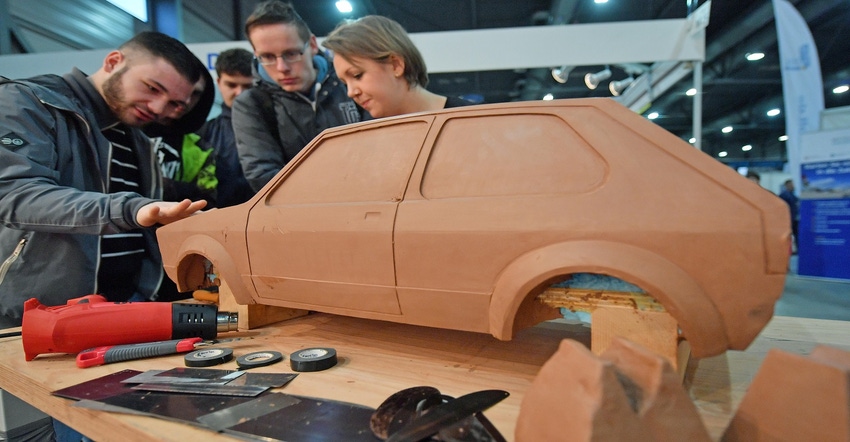Industry Voices: Design and Manufacturing Are Core to Sustainability
Autodesk’s Zoé Bezpalko points to the design and manufacturing stages as the key to creating environmentally friendly products.
August 4, 2022

For manufacturers, sustainability is about creating technology that improves energy and material productivity. To provide sustainability, manufacturers need to improve operations and processes, but also improve the products that are manufactured. Digitization and circularity have become important concepts. Digitalization can unlock the value of data and create solutions that contribute to sustainability. Circularity means extending the product’s useful life, finding new use at the end of life, or preparing for recycling.
We caught up with Zoé Bezpalko, sustainability strategy manager at Autodesk. She is a designer and environmental engineer who believes in the strategic use of technology and design as keys to solving global issues like climate change. At Autodesk, she leads the sustainability strategy for the design and manufacturing industries.

Design News: Sustainability is becoming more important to manufacturers and their partners. What’s driving this?
Zoé Bezpalko: Three years ago, we assessed our customer engagement and commitment to sustainability. In 2019, 52% of our design and manufacturing customers had publicly stated sustainability goals, now it is 75%. My role is to drive the strategy for design and manufacturing through our industry and other industries.
Sustainability is central to Autodesk for several reasons. A lot of our customers are contributors to climate change. Eighty percent of the environmental impact of a product is determined at the design phase. We’re positioned to help customers reduce their environmental impact. This includes manufacturing, making, and operations.
Last year we had our environmental impact strategy signed off by Autodesk’s board and key staff. We look at our operation, how we work with customers, and how we can impact our industry.
DN: How does digitalization fit into sustainability?
Zoé Bezpalko: Sustainability is the topic that permeates digitalization. Just through digitalizing, you have an opportunity to affect sustainability, with the biggest impact in manufacturing.
The industry most interested in sustainability is consumer goods because of consumer demand. People are ready to pay more for sustainable products. They’re at the forefront because of the environmental pressures. Automotive as an industry isn’t far behind because regulations are pushing for the lightweighting of cars. In building products, there are also regulations around and pressures around building certifications like LEED. [The LEED certification program was devised in 1994 by the US Green Building Council to encourage sustainable practices in design and development.]
DN: Explain the idea of circularity and how it fits into sustainability.
Zoé Bezpalko: I see circularity as the North Star of sustainability. Circularity is the idea of keeping a product, its components, and materials at their highest value possible across the product lifecycle. In other words, nothing goes to waste. Circularity is the idea that nothing goes to waste. When you recycle you downgrade the material. But when you think cross-industry, you get a company that takes old carpets and turns them into auto interiors. The challenge is to take back the product and refurbish it so you get to resell it. Sustainable materials can cost more, but you have to think about it holistically. If you think of circularity as a different business model that makes you more competitive.
DN: What prompted the increased interest in sustainability?
Zoé Bezpalko: Consumer demand moved from it nice to have sustainable products to consumer activism. It’s the idea that people are now boycotting brands and avoiding air travel. There is the growth in the potential of getting boycotted if you don’t take the right action. Regulations also play a part. They are mostly coming from Europe. Soon in Europe, every product will have a Digital Product Passport to ensure transparency and traceability across the value chain. There are also regulations to make the product repairable for 10 years after the sale. Manufacturers need to have spare parts for 10 years after the sale.
The US is catching up with these regulations. We’re going to see requirements for US companies to report to their shareholders on environmental issues. If they have to report, they will need to measure and track.
Investors are investing in companies that can show sustainability. It becomes part of the cost of doing business. We at Autodesk did our first sustainability bond last year. The reason why investors are now interested in sustainability companies is that they are showing ROI for their sustainability practices.
DN: How important is lightweighting?
Zoé Bezpalko: We’ve been calculating the environmental impact of lightweighting for a long time. The Makersite – which is not Autodesk’s site – maintains a huge, highly detailed database of materials, manufacturing methods and locations, and more elements of product design and manufacturing. It uses that data to then assess how sustainable a product is that someone has designed and recommend alternatives that increase a product’s sustainability without diminishing its quality.
We’re working with Makersite to build this product sustainability scoring capability into Fusion 360. The site analyzes and assesses the environmental impact. You can see the carbon impact of this part. You can look at different materials. You can access them during your design. We are partnering with Makersite to integrate their carbon footprinting capabilities directly into Fusion 360.
About the Author(s)
You May Also Like





